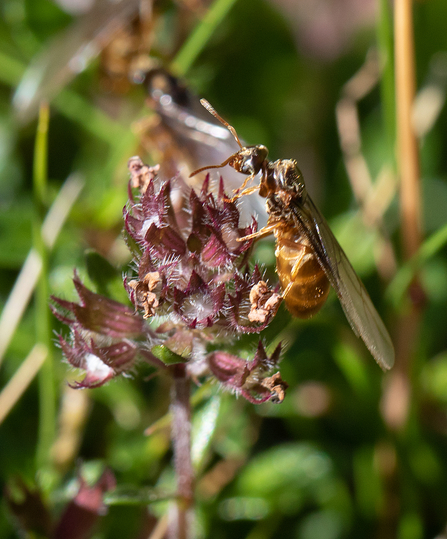Again this is all to do with reproduction and dispersal to set up new colonies. Interestingly the strategy between the ants and the bees differs in one crucial aspect. For the Honey Bee it is the old Queen who disperses to set up a new colony leaving developing fresh Queens behind. For the ants, however, the old Queen stays in the nest and it is the new Queens (charmingly known as princesses until they establish a new colony) who disperse. So the swarms of flying ants you see are the dispersing new females and associated males (drones), all the non-fertile worker ants remaining in the nest with the queen.
Insects on the move
Andy Karran
So why do so many appear at one time and form these swarms? The answer to this is multifarious:
- Their mass emergence is triggered by the weather, the ideal conditions are warm, still, sunny weather following rain. The fine, warm weather is important for them to be able to fly, the preceding rain is just as important however as they need the soil to be quite soft so that they can burrow in to it to start new colonies. Because they are all waiting for the same environmental cues it results in many colonies emerging at once over a large area, hence the huge swarms.
- There are benefits to this mass emergence swarming, it means that there is such a glut of available food for predators that they cannot possibly eat them all in such a short space of time - so some are guaranteed survival.
- The swarming also means that ants from different colonies will mix, which is important for the mixing of genetics. This is particularly important in species such as ants when you consider that all the ants from a colony are virtual clones of each other, all having come from the same queen.
Some people don’t like these swarms of flying ants, but spare a thought for the princess ants. They are entirely harmless and a great source of food for our much-loved birds such as Swifts and Swallows. And after she has mated, she has to bite her own wings off before burying in to the ground! Also out of a whole colony only one Princess may live to be a Queen. However, if she does, she may get to live an incredible 25 years, which is pretty good if living underground in perpetual darkness, constantly giving birth is your thing. As if this isn’t already more Hitchcock than Disney, the males all drop dead within two days of their maiden flight!

Andy Karran
Do your bit for bugs
Please take part in our Bugs Matter this summer - and help us to find out more about our insect populations in Gwent.
The survey, which runs until August 31st, is free to take part in - simply just download the free Bugs Matter app.
You can also find out more about what other Actions for Insects you can take here

Andy Karran
Ants with aphids

